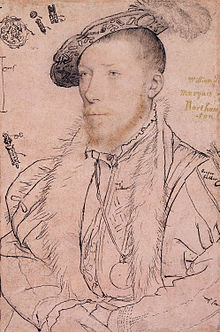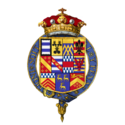William Parr, 1. Marquess of Northampton


William Parr, 1. Marquess of Northampton, KG (* 14. August 1513 entweder in Blackfriars, London oder in Kendal, Westmorland; † 28. Oktober 1571 in Warwick, England) war der Sohn von Sir Thomas Parr und Maud Green. Er war der Bruder von Catherine Parr, der sechsten Ehefrau von König Heinrich VIII.
Leben
William Parr wurde am 14. August 1513 als Sohn von Sir Thomas Parr, Gutsherr von Kendal, und Maud Green geboren und hatte zwei Schwestern, Catherine und Anne.
Er beteiligte sich 1537 an der Niederschlagung der Pilgrimage of Grace und wurde für Northamptonshire Abgeordneter im House of Commons. 1539 wurde er zum Baron Parr, of Kendal, erhoben und stieg ins House of Lords auf.
Er hatte am 9. Februar 1527 Anne Bourchier, 7. Baroness Bourchier, die Tochter von Henry Bourchier, 2. Earl of Essex († 1540) geheiratet. Die Ehe wurde am 17. April 1543 durch einen Act of Parliament annulliert und die Kinder (die Anne vermutlich von einem Geliebten hatte) zu Bastarden erklärt. Parr erhielt zudem die Ländereien seiner Exfrau. Nachdem seine Schwester Catherine im Juli 1543 König Heinrich VIII. geheiratet hatte, erwirkte er, dass sein Schwager ihm am 23. Dezember 1543 den Titel eines Earl of Essex neu verlieh.
Im April 1543 war er als Knight Companion in den Hosenbandorden aufgenommen worden.[1]
In zweiter Ehe heiratete er Elisabeth Brooke, Tochter von George Brooke, 9. Baron Cobham. Die Ehe wurde 1548 für gültig, 1553 für ungültig und 1558 wiederum für gültig erklärt.
Durch die Stellung seiner Schwester, gewann auch William Parr an Einfluss bei Hofe. Als Stiefonkel König Eduards VI. wurde Parr am 16. Februar 1547 zum Marquess of Northampton erhoben und war er einer der einflussreichsten Männer am Hofe König Eduards, vor allem während der Zeit, in der John Dudley, 1. Duke of Northumberland die Regierungsgeschäfte leitete. Als dieser nach Eduards Tod versuchte, Lady Jane Grey zur Königin zu ernennen, stellten sich Parr und seine Frau Elisabeth auf dessen Seite. Nachdem jedoch Königin Maria I. den Thron bestieg und Jane inhaftieren ließ, wurde auch Parr wegen Hochverrat am 18. August 1553 vom Parlament geächtet, verlor alle Titel und Ländereien und wurde zum Tode verurteilt. Allerdings wurde er im Herbst wieder freigelassen, seine Titel und Besitzungen wurden am 13. Januar 1559 von Elisabeth I. wiederhergestellt.[2]
Nachdem seine zweite Gattin Elisabeth 1565 kinderlos gestorben war, heiratete William Parr nur fünf Monate vor seinem Tod Helena Snakenborg (1549–1635), eine aus Schweden stammende Hofdame von Elisabeth I. Mit seinem Tod am 27. Oktober 1571 in Warwick erloschen alle seine Titel, da er keine Nachkommen hatte. Parr wurde in der St. Mary’s Church in Warwick begraben.[3]
Literatur und Weblinks
- Northampton, Earls and Marquesses of. In: Encyclopaedia Britannica. Band 19, London 1911, S. 765 ff.
- William Parr, 1st Marquess of Northampton auf thepeerage.com
Einzelnachweise
- ↑ William Arthur Shaw: The Knights of England. Band 1, Sherratt and Hughes, London 1906, S. 23.
- ↑ William Parr, Marquess Northampton. In: Encyclopaedia Britannica. Abgerufen am 14. April 2018 (englisch).
- ↑ Warter - Warwick-Bridge. A Topographical Dictionary of England. In: British History Online. Abgerufen am 14. April 2018 (englisch).
| Personendaten | |
|---|---|
| NAME | Parr, William, 1. Marquess of Northampton |
| ALTERNATIVNAMEN | Parr, William, 1. Earl of Essex |
| KURZBESCHREIBUNG | englischer Adliger |
| GEBURTSDATUM | 14. August 1513 |
| GEBURTSORT | unsicher: Blackfriars, London oder Kendal, Westmorland |
| STERBEDATUM | 28. Oktober 1571 |
| STERBEORT | Warwick, England |
Auf dieser Seite verwendete Medien
Autor/Urheber: Rs-nourse, Lizenz: CC BY-SA 3.0
Arms of w:William Parr, Marquess of Northampton (1513-1571), KG, the only brother of Queen Catherine Parr (1512-1548), the sixth and final wife of King Henry VIII, whom he married in 1543. On 23 April 1543, he became a Knight of the Garter and on 23 December 1543, just after his sister had married the king, he was created Earl of Essex. In 1547 he was created Marquess of Northampton. Coat of arms as seen on his Garter stall plate in St. George's Chapel, Windsor. The plate was formerly viewable online at the Royal Collection Trust website. (Sources:Tony Wilmott, Apethorpe Hall, Northamptonshire the Heraldic Decoration, 2009[1]) (see The Brooke Tomb, Cobham, Kent - Kent Archaeological Society[2]); Some notices of the Parr family may be found in the Topographer and Genealogist, vol. iii. p. 352
Quarterly of 11:
- 1: Parr: Argent, two bars azure a bordure engrailed sable
- 2: de Ros: Or, three water-bougets sable (Ross of Kendal, Westmorland, here shown with field argent)
- 3: FitzHugh: Azure, three chevrons interlaced in base or a chief of the last (Sir William Parr (1434–1483), KG, married w:Elizabeth FitzHugh (1455/65-1507), a daughter (and heiress) of Henry FitzHugh, 5th Baron FitzHugh (c. 1429–1472), of Ravensworth in North Yorkshire. The arms of FitzHugh (quartering Marmion of Tanfield Castle) impaling Neville (quartering Montacute and Monthermer) survive in a stained glass window in St Mary's Church, Wath-by-Rippon, Yorkshire.
- 4: Staveley: Barry argent and gules, a fleur de lys sable (an heiress of FitzHugh) Alice de Staveley, daughter and heiress of Adam de Staveley, married Ranulf son of Henry of Ravensworth, the ancestor of the family of Fitzhugh (https://www.staveley-genealogy.com/the_first_staveleys.htm);
- 5: Furneaux (of w:Carlton in Lindrick, Nottinghamshire): Gules, a bend between six cross-crosslets or (an heiress of FitzHugh) here shown as Gules, a bend between six cross-crosslets argent
- 6:Barry of six argent and azure, on a bend gules three martlets or (Grey of Wilcote, Oxfordshire, a difference of Grey of Rotherfield); John de Grey, 1st Baron Grey of Rotherfield (1300-1359) married firstly Catherine FitzAlan, by whom he had a son and heir John Grey, 2nd Baron Grey of Rotherfield. Secondly John de Grey, 1st Baron Grey of Rotherfield married Avice Marmion, one of the two sisters and co-heiresses of Robert Marmion, 3rd Baron Marmion (d.1360), of Tanfield, Nottinghamshire. By Avice Marmion he had two further sons: Sir John "de Marmion" of Tanfield, who became heir to his mother and adopted the surname "Marmion" in lieu of his patronymic; died without issue; the second son was Sir Robert de Grey (d.1367) of Wilcote, Oxfordshire (a Grey manor), who married Lora de St Quentin, younger daughter and co-heiress of Sir Herbert de St Quentin. Sir Robert de Grey (d.1367) of Wilcote appears to have adopted the martlets as a difference to his paternal arms (which descended to his elder half-brother John Grey, 2nd Baron Grey of Rotherfield). Sir Robert de Grey of Wilcote left an only daughter and sole heiress Elizabeth Grey (also heiress of her uncle Sir John "de Marmion" of Tanfield) who married w:Henry FitzHugh, 3rd Baron FitzHugh (c. 1358–1425).
- 7: Marmion: Vair, a fess gules (an heiress of Grey)
- 8: Gernegan of Tanfield: Barry or and azure, an eagle gules (an heiress of Marmion)
- 9: St Quentyn: Or, three chevronels gules a chief vair (an heiress of Grey)
- 10: Greene of Boughton, Northamptonshire: Azure, three stags trippant or ('Parishes: Boughton', in A History of the County of Northampton: Volume 4, ed. L F Salzman (London, 1937), pp. 76-81 [3]). The mother of William Parr, Marquess of Northampton was w:Maud Green (1492-1531), a daughter and co-heiress of Sir Thomas Green of Green's Norton in Northamptonshire and a close friend and lady-in-waiting to Queen Catherine of Aragon.
- 11: Mablethorpe: Gules, a chevron or between three cross-crosslets argent in chief a lion passant of the last (an heiress of Greene)
From: Tony Wilmott, Apethorpe Hall, Northamptonshire the Heraldic Decoration, 2009[4]: Quartered arms of William Parr, 1st Earl of Northampton (d. 1571), brother of Queen Katherine Parr. His quarterings appear on his Garter stall plate, and were probably those that appeared here: Quarterly of ten: (1) argent, two bars azure within a bordure engrailed sable (Parr), (2) or, three water boudgets sable (Roos), (3) azure, three stags trippant or (Greene), (4) gules, a chevron between three crosses crosslet, in chief a lion passant guardant or (Mablethorpe), (5) azure, three chevronels braced in base, and a chief or (Fitzhugh), (6) vair, a fess gules (Marmion), (7) or, three chevronels gules, a chief vair (St Quentyn), (8) gules, a bend between three crosses crosslet or (Forneux), 9) barry argent and gules, a fleur de lis sable (Staveley), (10) barry or and azure, ann eagle displayed gules (Garnegan)
Gregory Fiennes, Baron Dacre of the South (d.1594) displayed many of these quarterings: Dacre, Multon, Vaux, Morville, Fitzhugh, Stavely, Furneaux, Grey, Marmion, St. Quentin and Gernegan. Lord Dacre had no children, but his heraldry survives in the Arms of Emanuel School in Clapham[5] founded by his widow. (https://heraldictimes.wordpress.com/2010/12/06/elaboration-of-coats-of-arms/)Black and coloured chalks, pen and Indian ink, white bodycolour, on pink-primed paper,
The chalks are rubbed but the high-quality penwork is recognisable as Holbein's.[1] His extensive colour notes show that the planned oil portrait would have depicted Parr in the costly satin and white and purple velvet of the nobility. A sketch on the left details the links of a chain, including the word "MORS" (death), perhaps connected to a motto. A design at top left shows a figure, possibly representing St George and the Dragon as the motif for the hat badge.[2] William Parr, 1st Marquess of Northampton (1513–71), was a leading courtier under Henry VIII, Edward VI, and Elizabeth I, though he was out of favour under Mary I, when the government stripped him of his titles and declared his marriage illegal. Parr rose to power as the younger brother of Katharine Parr, the sixth wife of Henry VIII.
References

